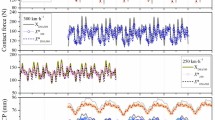Abstract
Appropriate contact force is required for the pantograph on the high speed train to collect current from the catenery system without separation. However, at high speed, large aerodynamic lifting force is generated by the contact plate and the body of pantograph, which may cause wear of the contact wire. In this study, to confirm the interface performance of the pantograph on Korea High Speed Train, a method to measure the contact force of the pantograph was proposed and the related measuring system was developed. The forces acting on the pantograph were clarified and a practical procedure to estimate the forces was proposed. A special device was invented and applied to measure the aerodynamic lifting force. Measured contact forces were displayed by the developed system and evaluated based on the criteria.
Similar content being viewed by others
Abbreviations
- a:
-
Acceleration of contact plate
- Fac :
-
Aerodynamic lifting force of contact plate
- \(\overline {F_{ad} } \) :
-
Average aerodynamic lifting force of contact plate in N
- \((\overline {F_{ac} } )_{run} \) :
-
Average aerodynamic lifting force of contact plate in running test
- \((\overline {F_{ac} } )_{wind} \) :
-
Average aerodynamic lifting force of contact plate in wind tunnel test
- Fah :
-
Aerodynamic lifting force of horn frame
- Fc :
-
Contact force of contact plate
- \(\overline {F_c } \) :
-
Average contact force of contact plate in N
- Fsp :
-
Spring force below contact plate
- \(\overline {F_{sp} } \) :
-
Average spring force below contact plate
- k:
-
Coefficient of aerodynamic lifting force
- kwind :
-
Coefficient of aerodynamic lifting force from wind tunnel test
- mcp :
-
Mass of contact plate
- V:
-
Train velocity in km/h
References
Alstom, 2001, “Qualification Test Procedure — Trainset Pantograph Test,”Korea High Speed Rail Specification, K651-1-E5330-RB+T-017, pp. 28–30.
Bae, J. C, Jung, G. R. and Kim, H. J., 2001., “Development of Pantograph for Korea High Speed Train,”Korea Ministry of Construction and Transportation Report, No. 00-11-2-1-10, pp. 119–133.
Ikeda, M. and Usuda, T., 2000, “Study on the Method of Measuring the Contact Force between Pantograph and Contact Wire,”RTRI Report, Vol. 14, No. 6, pp. 7–12.
Kim, J. W., Park, I. K., Jang, J. H., Wang, Y. Y. and Han, C. S., 2003, “A Modeling and Contact Force Analysis of the Catenary-pantograph System for a High Speed Rail Vehicle,”Transactions of the Korean Society for Noise and Vibration Engineering, Vol. 13, No. 6, pp. 474–483.
Kim, K. H., Jung, G. R. and Lee, B. S., 2002, “System Specification for G7 Korean High Speed Train,”Korea Railroad Research Institute Report, pp. 51–53.
Park, T. J., Kim, B. J. and Wang, Y. Y., 2002, “A Catenary System Analysis for Studying the Dynamic Characteristics of a High Speed Rail Pantograph,”KSME International Journal, Vol. 16, No. 4, pp. 436–447.
Seo, S. I., Park, C. S., Cho, Y. H., Choi, K. Y. and Mok, J. Y., 2003, “Test and Evaluation of the Pantograph for Korea High Speed Train,”Journal of the Korean Society for Railway, Vol. 6, No. 2, pp. 94–99.
UIC, 1996, “Pantograph—Overhead Line Interaction on the European High Speed Network,”International Union of Railway, UIC 794, pp. 1–30.
Author information
Authors and Affiliations
Corresponding author
Rights and permissions
About this article
Cite this article
Seo, SI., Cho, YH., Mok, JY. et al. A study on the measurement of contact force of pantograph on high speed train. J Mech Sci Technol 20, 1548–1556 (2006). https://doi.org/10.1007/BF02916259
Received:
Revised:
Issue Date:
DOI: https://doi.org/10.1007/BF02916259




